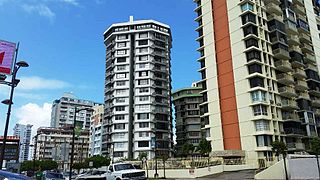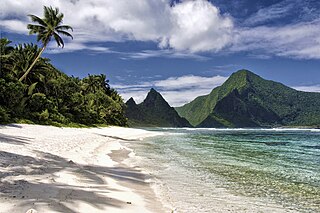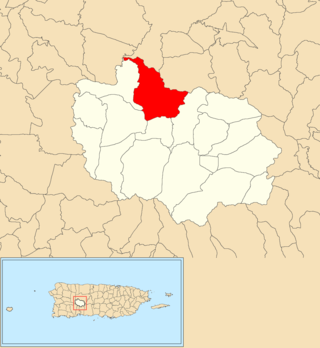Related Research Articles

The Treaty of Peace between the United States of America and the Kingdom of Spain, commonly known as the Treaty of Paris of 1898, was signed by Spain and the United States on December 10, 1898, that ended the Spanish–American War. Under it, Spain relinquished all claim of sovereignty over and title to territories described there as the island of Porto Rico and other islands now under Spanish sovereignty in the West Indies, and the island of Guam in the Marianas or Ladrones, the archipelago known as the Philippine Islands, and comprehending the islands lying within the following line:, to the United States. The cession of the Philippines involved a compensation of $20 million from the United States to Spain.

Carolina is a city and municipality located on the northeast coast of Puerto Rico. It lies immediately east of the capital San Juan and Trujillo Alto; north of Gurabo and Juncos; and west of Canóvanas and Loíza. Carolina is spread over 12 barrios plus Carolina Pueblo. It is part of the San Juan-Caguas-Guaynabo Metropolitan Statistical Area, and home to Puerto Rico's main airport, the Luis Muñoz Marín International Airport.

In the law of the United States, an insular area is a U.S.-associated jurisdiction that is not part of a U.S. state or the District of Columbia. This includes fourteen U.S. territories administered under U.S. sovereignty, as well as three sovereign states each with a Compact of Free Association with the United States. The term also may be used to refer to the previous status of the Swan Islands, Hawaii, Puerto Rico, and the Philippines, as well as the Trust Territory of the Pacific Islands when it existed.

Territories of the United States are sub-national administrative divisions overseen by the federal government of the United States. The various American territories differ from the U.S. states and Indian reservations as they are not sovereign entities. In contrast, each state has a sovereignty separate from that of the federal government and each federally recognized Native American tribe possesses limited tribal sovereignty as a "dependent sovereign nation." Territories are classified by incorporation and whether they have an "organized" government through an organic act passed by the Congress. American territories are under American sovereignty and, consequently, may be treated as part of the United States proper in some ways and not others. Unincorporated territories in particular are not considered to be integral parts of the United States, and the Constitution of the United States applies only partially in those territories.

Arroyo is a town and municipality located along the southern coast of Puerto Rico and bordered by the Caribbean Sea, east of the municipality of Guayama and northwest of the municipality of Patillas. Arroyo is spread over 5 barrios and Arroyo barrio-pueblo. It is part of the Guayama Metropolitan Statistical Area.

Hatillo is a town and municipality located in Puerto Rico's north coast, bordered by the Atlantic Ocean to the north, Lares and Utuado to the south, Camuy to the west, and Arecibo to the east. According to the 2000 US Census Hatillo is spread over nine barrios and Hatillo Pueblo. It is part of the San Juan-Caguas-Guaynabo Metropolitan Statistical Area.

Ángel Rivero Méndez was a Puerto Rican soldier, writer, journalist and a businessman. Rivero Méndez was a Captain in the Spanish Army during the Spanish–American War and is credited with ordering the first shot against the United States in Puerto Rico in said conflict. After the war, he became a US Citizen and upon his retirement, he wrote Crónica de la guerra hispano-americana en Puerto Rico, a chronicle of the Spanish-American War in Puerto Rico. He is also credited with inventing a carbonated drink called Kola Champagne which is still sold today.

This is a survey of the postage stamps and postal history of Cuba.
The United States House Committee on Insular Affairs is a defunct committee of the U.S. House of Representatives.

Isabel González was a Puerto Rican activist who helped pave the way for Puerto Ricans to be given United States citizenship. As a young unwed pregnant woman, González had her plans to find and marry the father of her unborn child derailed by the United States Treasury Department when she was excluded as an alien "likely to become a public charge" upon her arrival in New York City. González challenged the Government of the United States in the groundbreaking case Gonzales v. Williams. Officially the case was known as Isabella Gonzales, Appellant, v. William Williams, United States Commissioner of Immigration at the Port of New York No. 225, argued December 4, 7, 1903, and decided January 4, 1904. Her case was an appeal from the Circuit Court of the United States for the Southern District of New York, filed February 27, 1903, after also having her writ of habeas corpus dismissed. Her Supreme Court case is the first time that the Court confronted the citizenship status of inhabitants of territories acquired by the United States. González actively pursued the cause of U.S. citizenship for all Puerto Ricans by writing letters published in The New York Times.
Puerto Rico is an island in the Caribbean region in which inhabitants were Spanish nationals from 1508 until the Spanish–American War in 1898, from which point they derived their nationality from United States law. Nationality is the legal means by which inhabitants acquire formal membership in a nation without regard to its governance type. In addition to being United States nationals, persons are citizens of the United States and citizens of the Commonwealth of Puerto Rico within the context of United States Citizenship. Miriam J. Ramirez de Ferrer v. Juan Mari Brás. Citizenship, the rights and obligations that each owes the other, once one has become a member of a nation. Though the Constitution of the United States recognizes both national and state citizenship as a means of accessing rights, Puerto Rico's history as a territory has created both confusion over the status of its nationals and citizens and controversy because of distinctions between jurisdictions of the United States. These differences have created what political scientist Charles R. Venator-Santiago has called "separate and unequal" statuses.

Mercado, located within Old San Juan, is one of 7 subbarrios in San Juan Antiguo barrio in the municipality of San Juan in Puerto Rico.

Large-scale Chinese immigration to Puerto Rico and the Caribbean began during the 19th century. Chinese immigrants had to face different obstacles that prohibited or restricted their entry in Puerto Rico.

San Juan Antiguo (not to be confused with the historic district of Old San Juan which is located within this district), is a barrio located in the municipality of San Juan in the Commonwealth of Puerto Rico. San Juan Antiguo has 7 subbarrios. In 2010, San Juan Antiguo had a population of 7,085 inhabitants and a population density of 2,681.9 people per km2. San Juan Antiguo is entirely located within the Isleta de San Juan, the islet off the coast of Puerto Rico where Old San Juan was settled, connected to the mainland by bridges and a causeway.

Guayo is a rural barrio in the municipality of Adjuntas, Puerto Rico.

Sumidero is a barrio in the municipality of Aguas Buenas, Puerto Rico. Its population in 2010 was 8,008. In Sumidero barrio is part of the Aguas Buenas urban zone and the Santa Clara community.

Palmas is a barrio in the municipality of Arroyo, Puerto Rico. Its population in 2010 was 3,789.

Quebrada Grande is a barrio in the municipality of Barranquitas, Puerto Rico. Its population in 2010 was 3,217.

Tanamá is a rural barrio in the municipality of Adjuntas, Puerto Rico. Its population in 2010 was 1,193.

Guamaní is a barrio in the municipality of Guayama, Puerto Rico. Its population in 2010 was 1,455.
References
- ↑ Charles Henry Butler (1902). The treaty making power of the United States. The Banks Law Pub. Co. p. 441 . Retrieved April 9, 2011.